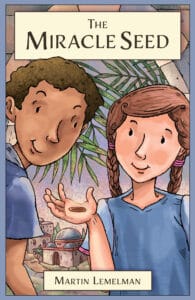New Life from Ancient Seeds
June 6, 2023 in Library Corner
By Robin Jacobson.
“The righteous bloom like a date-palm . . .” Psalm 92:13
 Among the glories of ancient Israel were its flourishing Judean date palm trees, celebrated for their beauty, shade, and sweet fruit. Long extinct, the Judean date palm is experiencing a miraculous rebirth, thanks to two Israeli scientists who saw potential in ancient date palm seeds found at Masada. This inspiring, true story is captivatingly told in The Miracle Seed by Martin Lemelman, a deeply researched, comic-book-style book for young readers (ages 8-14), but fascinating for adults too.
Among the glories of ancient Israel were its flourishing Judean date palm trees, celebrated for their beauty, shade, and sweet fruit. Long extinct, the Judean date palm is experiencing a miraculous rebirth, thanks to two Israeli scientists who saw potential in ancient date palm seeds found at Masada. This inspiring, true story is captivatingly told in The Miracle Seed by Martin Lemelman, a deeply researched, comic-book-style book for young readers (ages 8-14), but fascinating for adults too.
A Victim of War
In the ancient world, Judean dates were a prized commodity. As Lemelman relates, notable Greek, Roman, and Jewish writers extolled their sweetness, long shelf-life, and uses in treating a variety of medical ills. King Herod of Judea made a gift of the famous fruit to the Roman Emperor each year. But its value did not spare the Judean date palm from the ravages of war.
After Roman soldiers razed Jerusalem in 70 C.E., they spread across the land, destroying towns, villages, and thousands of Judean date palm trees. Roman victory coins of the era, “Judea Capta” (Judea conquered), depict a weeping woman (symbolizing the conquered people) by a Judean date palm (representing the conquered land).
Exiled and enslaved, the Jews could no longer tend the surviving Judean date palms. The species fell victim to further violence and destruction during the Crusades and finally became extinct about 1,000 years ago.
A Discovery at Masada
Until its capture in 73 C.E., the mountaintop fortress of Masada had been the last Jewish stronghold against the Romans. Rather than surrender, the defenders on Masada famously took their own lives. Their belongings – scrolls, sandals, coins, and pottery – remained on the mountaintop for two millennia.
In 1963, archaeologist Yigael Yadin assembled a multinational team of volunteers to dig through the rubble of Masada. Among many artifacts, they discovered a clay jar containing six 2,000-year-old Judean date palm seeds. Somehow, these wound up in a drawer at Israel’s Bar-Ilan University, where they remained for 40 years.
Pioneering Scientists
In 2004, Dr. Sarah Sallon, the Director of Hadassah’s Natural Medicine Research Center in Jerusalem, became curious about the once-legendary health benefits of the Judean date palm. Although an extinct plant had never been brought back to life, she wondered if it might be possible. Sallon obtained permission to use three of the Masada seeds and persuaded Dr. Elaine Solowey, one of Israel’s top plant experts, to collaborate with her.
Dr. Solowey bathed the ancient seeds in warm water, nutrients, and fertilizer made from seaweed. She planted the seeds in January 2005 – on Tu B’Shevat, the New Year for the Trees. Six weeks later, a tiny sprout cracked the soil. The joyful scientists named it Methuselah after the longest-lived person in the Bible.
Methuselah, a male date palm, gradually matured; its first flower blossomed in 2011. But to produce dates, the pollen from Methuselah’s flowers needed to reach a female date palm. Dr. Sallon searched for more ancient date palm seeds in archaeological collections, obtaining 32 for Dr. Solowey to plant. One of the six seeds that sprouted grew into a female date palm that the scientists named Hannah.
In 2020, Dr. Solowey carefully collected Methuselah’s pollen. With a paintbrush, she delicately dusted the pollen onto Hannah’s flowers. By the end of that summer, Hannah had dates ready to pick. Reciting the Shehecheyanu prayer to mark a first-ever experience, Drs. Solowey and Sallon split a date and tasted it. What does history taste like? They reported that the miracle date had a sweet, honey-like, slightly nutty flavor and was altogether delicious.